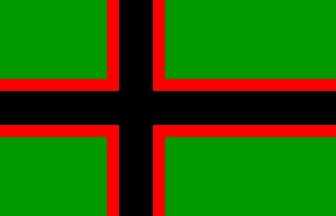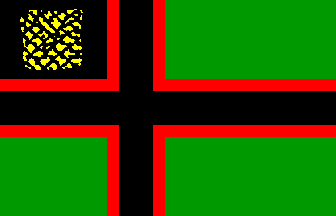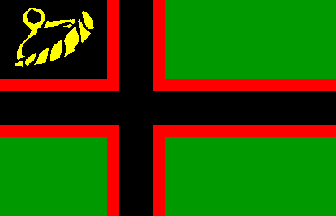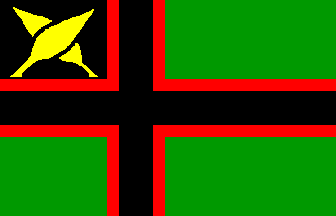
Last modified: 2021-08-26 by valentin poposki
Keywords: gallén-kallela (akseli) | aurora borealis | northern lights | swallowtail | bear (black) | chain | cross: scandinavian (black) | cross: scandinavian (blue) | earth | sorrow | hope | forests | joy | blood | oar | pilot |
Links: FOTW homepage |
search |
disclaimer and copyright |
write us |
mirrors

The East Karelians were quickly caught in the middle of the struggles between red and white Russian forces, the intervention forces under the British and Finnish volunteer expeditions. The military situation changed quickly. However, the East Karelians worked to set up a government of their own.
In July 1919 a conference of delegates from White Sea Karelian parishes met in Uhtua and appointed an East Karelian Committee that acted as a provisional government of East Karelia. This provisional government organized the first East Karelian Diet, elected by universal suffrage and consisting of representatives from twelve municipalities (or parishes). The Diet sat from 21 March to 1 April 1920 in Uhtua and appointed a regular six-member government. On 22 March the diet called for independence from Russia and adopted arms and a flag. The flag and arms were designed by Finnish artist Akseli Gallén-Kallela.
Jan Oskar Engene, 23 May 1997
A second East Karelian Diet, meeting 11-16 June 1920, voted to set up an
army and to mobilize. However, the red Russian forces took the East Karelian
territory in the early summer of 1920 and the at the end of June the East
Karelian government fled to Finland. In exile the government of East Karelia
joined forces with the Government of Aunus and representatives of two
municipalities to form a Karelian Central Government and a Karelian Foreign
Delegation (December 1920). In East Karelia itself, resistance was organized
against the Russian Bolsheviks. A war of liberation was launched in 1921-22
and a new temporary government appointed at Uhtua. The struggle was
unsuccessful in the end and the government was forced to flee to Finland
once again.
Jan Oskar Engene, 23 May 1997
Paskov [pas94] shows three varieties of
the flag. One is a Scandinavian cross flag of green field with a black cross
bordered in red. This flag is simply labelled the flag of East Karelia by
Paskov.
Jan Oskar Engene, 23 May 1997
Among the colours of the East Karelian flag black stands for the earth
and the sorrowful history of the region, green for the abundant forests
as well as hope for a better future and red for blood and joy. The flag
has also clearly inspired the Vepsian and
Ludian ethnic flags.
Marco Pribilla, 10 Jan 2003
According to Laurla, [lau97]
the cross flag «is now used as an ethnic flag of the original Carelians in
the Russian Republic of Carelia». Thus, it appears that it has no official
status, but that it is actually in use by Karelians (I have myself seen a
photo of this flag flying on a small boat on an East Karelian lake).
Jan Oskar Engene, 17 Jul 2000
It may also be interesting to note here that when a new flag and emblem
for the post-soviet Republic of Karelia were debated
in 1992, Vitali Dobrynin proposed emblems based on Gallén-Kallelas
designs, differing only in the number of the white triangles that had been
reduced to 19 (10+9) in order match the number of rayons and cities in the
Republic.
Marco Pribilla, 10 Jan 2003
Reading [lau97], it seems fairly clear
that compared to the flag of Finland, the cross flag
of East Karelia was similar, but not
identical. The slight difference is
due to the narrow red cross, which has just been added to the model
provided by the Finnish flag. I am not sure about proportions for the
swallow-tailed war flag.
Jan Oskar Engene, 17 Jul 2000
The dimensions of the cross differ among all flags shown in Paskov’s
book [pas94], but I doubt that this was
actually the case.
Jan Oskar Engene, 23 May 1997

Examining the book in question [lau97], I found two sketches (page 42) with the following proportions written down next to them:
(5,7-0,9-2,5-0,9-5,7) : (7,7-0,9-2,5-0,9-12,4) [a].
One of the sketches comes from the archive of W. Keynäs who was an important person in the East Karelian governments around 1920 and it is probably one of the originals by the artist Akseli Gallén-Kallela.
Marco Pribilla, 10 Jan 2003

However, the question seems indeed to be more complicated than that. Along the edges of the other sketch shown in the book [lau97], there are small marks that can be interpreted as pointing out the proportions as
(4-0,5-2-0,5-4) : (5-0,5-2-0,5-10) [b]:
Two different proportions in one sketch! In the latter, if the red borders are added to the width of the black cross, the proportions are indeed identical to those of the Finnish flag (4-3-4) : (5-3-10).
Unfortunately, the main question still remains: which proportions are correct? Laurla gives no further indication to this in his text. My personal impression is nevertheless that the [a] proportions would be the official ones, determined by Gallén-Kallela and perhaps even officially adopted by the East Karelian authorities some time during the year 1920 (but hardly before June since Gallén-Kallela didn’t post the designs to the government until 25th May; the flag decided upon in March 1920 but never officially adopted was a horizontal bicolour with the stars of the Plough).
Speculating a bit, if the official proportions of the East Karelian flag were not widely known, perhaps some of the East Karelian flags were produced following the Finnish pattern that was lying at hand. Hence, the [b] proportions would be a de facto variation. Although it is not easy to tell, the proportions that Laurla has used in his own illustrations seem to be closer to [a], so I tend to place my bet on them on being the official ones.
Marco Pribilla, 10 Jan 2003

A similar flag with a red canton set with six white design elements
representing the northern lights (aurora borealis) is lablled
«The Civil / Folk Flag of the Uhtua Government» by Paskov
[pas94], which sounds strange. Laurla
[lau97] mentions this as the state flag
of East Karelia.
Jan Oskar Engene, 17 Jul 2000 and 23 May 1997
The state flag has naturally the same proportions
as the national flag. The number of white triangles
(“northern lights” or “wolf’s teeth”) in
the red canton was meant by Gallén-Kallela to symbolise the
municipalities which at the time (1920) amounted to 53. They appear in six
elements with nine triangles each. Because 6×9=54, one of the
elements should actually contain only eight triangles but I
couldn’t find out which one.
Marco Pribilla, 10 Jan 2003
According to Laurla [lau97], several unofficial variants of the state flag existed:




The third flag, the war flag, has short swallowtails and tongue (like
some Finnish flags) and an adaption of the arms
in both green fields close to the hoist. This consists of a bear raising
a sword over its head and standing on a broken chain. Over the head of the
bear is set four white aurora borealis elements.
Paskov [pas94] shows this without the red
square in the intersection of the arms of the cross, which appears to be
wrong.
Jan Oskar Engene, 17 Jul 2000 and 23 May 1997
The red square should definitely be there. Laurla mentions it in his
book [lau97] and it also appears in all
the images. In the illustrations of Pashkov’s book
[pas94] there are several errors and
inaccuracies and the missing red square is clearly one of them. About
the proportions of the war flag I found no specifications, so the image
above is based on the national flag — although
looking at the images in Laurla’s [lau97]
book it seems that the cross may have been closer to the hoist than in the
other flags. Also the number of white triangles in the canton has varied,
being usually 4×9 (my image) instead of 53 in the original design.
On the coat of arms (and hence on the war flag, too) the triangles were
placed in four elements (13+13)/(13+14) even if in most reproductions all
of the elements contain either 13 or just 9 triangles.
Marco Pribilla, 10 Jan 2003

Unfortunately there isn’t too much info about these flags in the
book [lau97]. Laurla writes that they were
probably adopted in 1921 or 1922 but were perhaps never even manufactured
before the white troops were driven over the border to Finland by the red
Russian forces.
Marco Pribilla, 10 Jan 2003
The symbol on the customs flag is a traditional Finnish rucksack made of
tree bark (tuohikontti).
Marco Pribilla, 10 Jan 2003

Unfortunately there isn’t too much info about these flags in the
book [lau97]. Laurla writes that they were
probably adopted in 1921 or 1922 but were perhaps never even manufactured
before the white troops were driven over the border to Finland by the red
Russian forces.
Marco Pribilla, 10 Jan 2003
The symbol on the post flag is a traditional Finnish horn made of tree bark
(tuohitorvi).
Marco Pribilla, 10 Jan 2003

Unfortunately there isn’t too much info about these flags in the
book [lau97]. Laurla writes that they were
probably adopted in 1921 or 1922 but were perhaps never even manufactured
before the white troops were driven over the border to Finland by the red
Russian forces.
Marco Pribilla, 10 Jan 2003
In Laurla’s book [lau97], it is
difficult to understand just from the drawing, thought the emblem on the
pilot flag might be a pair of crossed oars).
Jan Oskar Engene, 17 Jul 2000
The emblem on the pilot flag is not explained in Laurla’s book
[lau97] but it might well be a pair of
crossed oars as suggested.
Marco Pribilla, 10 Jan 2003

The war pennant was green with a black cross in the long red field at
the hoist. It was attached to the mast twistably with one lanyard, like
the Finnish “husband pennants”.
Marco Pribilla, 10 Jan 2003
Unfortunately there isn’t too much info about these flags in the
book [lau97]. Laurla writes that they were
probably adopted in 1921 or 1922 but were perhaps never even manufactured
before the white troops were driven over the border to Finland by the red
Russian forces. The same applies to the war pennant that was probably meant
to be used on vessels on the lakes Ladoga / Laatokka and Onega /
Ääninen as well as on the White Sea.
Marco Pribilla, 10 Jan 2003
Anything below this line was not added by the editor of this page.